In the vast and vibrant world of Monster Hunter Wilds, mastering the art of capturing both colossal monsters and elusive endemic life is key to survival and progression. Whether you’re setting intricate traps for towering beasts or carefully netting rare insects and lizards, this guide reveals the essential strategies and tools you need to become a top-tier hunter on PC, PlayStation, and Xbox.
You can also capture small monsters, known as endemic life – the little bugs and lizards you see running around – to earn some extra Guild Points and to complete certain side quests.
Our Monster Hunter Wilds guide will tell you all about capturing monsters large and small, and how to craft the materials you’ll need for capturing them.
Update (March 12): Added details of which monsters cannot be caught, as well as an explainer on why you should consider capturing over killing monsters.
Why to capture vs. kill in Monster Hunter Wilds
Capturing monsters in Monster Hunter Wilds offers several advantages over killing them. It significantly shortens the hunt by allowing you to avoid the monster’s final, often most aggressive phase, enabling faster quest completion and more hunts in less time. Capturing also tends to yield more target rewards, including decorations and additional monster materials, which can be more beneficial in the long run. However, if you need specific parts that only drop from carving, such as tails or claws, it may be better to kill the monster after breaking those parts. In general, capturing is preferred for efficiency and resource gain, but killing is advisable when targeting particular materials that require carving.
The biggest advantage to capturing a monster in a trap is that it ends the fight immediately and much sooner than a fight to the death.
Most of the time, though, you’re going to be hunting monster for specific materials to make armor or weapons.
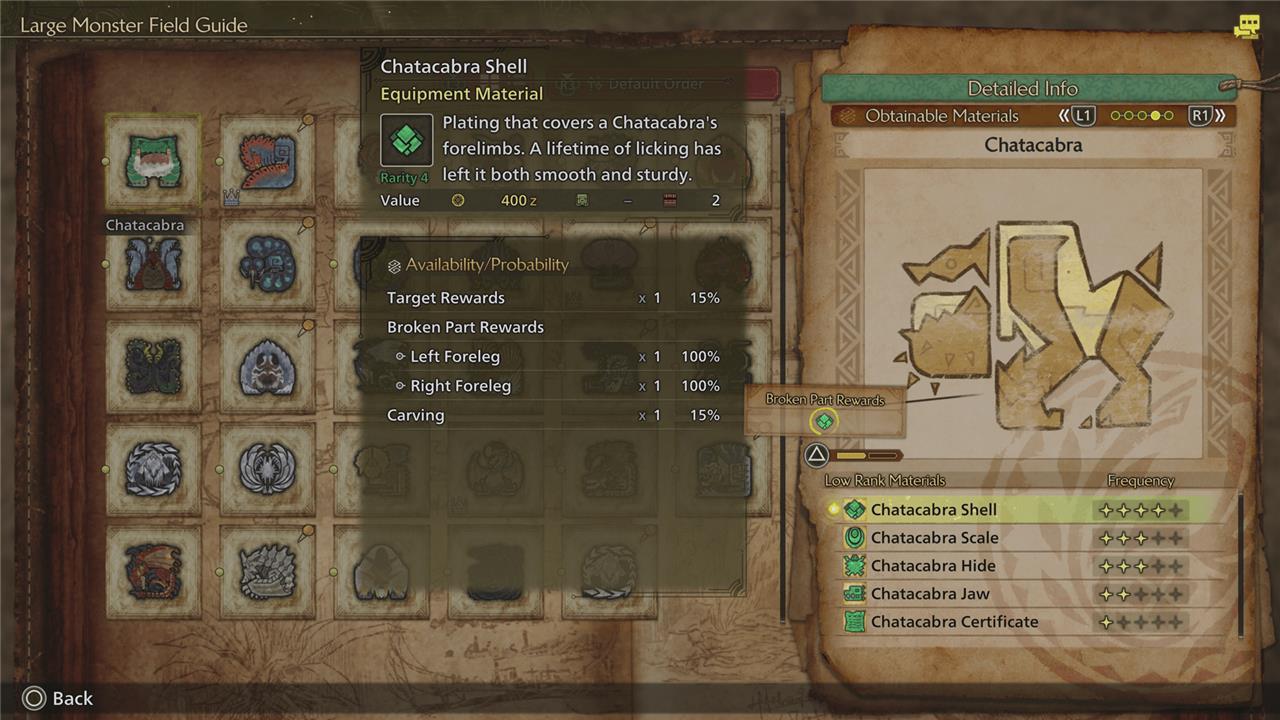
In the field guide, you can check the various materials you might get from a hunt on the Obtainable Materials tab. When you click through, you’ll see a list of percentages and locations. Target rewards are the rewards at the end of a hunt (independent of carving), broken part rewards are the material you might get when you attack a specific part of the monster, and carving are those three parts you get when you carve a monster after slaying it. The other rewards you get are from the hunt itself – those are the quest rewards you’ll see when you visit the quest counter.
After that, it gets into percentages of target rewards versus carving rewards. There are arguments to be made for both slaying and capturing, but it really comes down to the time and effort you want to spend on a hunt. Capturing a monster ends the hunt much faster and at the cost of only a trap and a couple of tranq bombs. Killing a monster will cost you time, potions, and runs the risk of you failing. But, slaying a monster has a (slightly) better chance of collecting the materials you’re after. (Sometimes. Usually. Look, math is hard.)
Some hunts will require you to slay a monster – especially some of the main and side story quests. Any time you see the word slay in your objectives, trapping them won’t work.
When can you capture monsters in Monster Hunter Wilds?
In Monster Hunter Wilds, you can capture monsters once their health is critically low, indicated by visual cues such as the monster limping, breathing heavily, or a flashing skull icon next to its minimap symbol. At this point, you need to set a trap-either a Shock Trap or Pitfall Trap-and then use tranquilizer items like Tranq Bombs to capture the monster. Although the official capture tutorial only appears after completing the main story and reaching High Rank, you can start capturing monsters earlier as soon as you have crafted the necessary traps and tranquilizers. Capturing monsters instead of killing them often yields better rewards and is required for certain quests.
Technically, you can capture monsters at any time in Monster Hunter Wilds provided you have the necessary traps – see a later section on how to craft these. As soon as you can wear a monster down, and can craft traps and tranq bombs, you’re ready. You don’t need to formally “unlock” anything.
That said, you won’t get an official quest that involves capturing a monster until after the credits roll in the main story and you enter High Rank, though. In that mission, Chapter 4-1 “New Ecosystems,” you’ll get the tutorial popup for how to capture.
Again, you can still capture large monsters at any time if you prefer to get started ahead of then, as explained below.
How to capture monsters in Monster Hunter Wilds
To capture monsters in Monster Hunter Wilds, first weaken the monster until its health is critically low, indicated by visual cues like limping or a skull icon on the minimap. Then, equip and set a trap-either a Shock Trap or Pitfall Trap-near the monster’s path. Once the monster is trapped and immobilized, use Tranq Bombs, Tranq Ammo, or Tranq Knives to tranquilize it until the capture is successful. Carrying both types of traps and plenty of tranquilizers is recommended, as some monsters resist certain traps. Capturing monsters yields better rewards than killing them and is required for some quests. You can craft the necessary traps and tranquilizers at your base camp using resources gathered in the field.
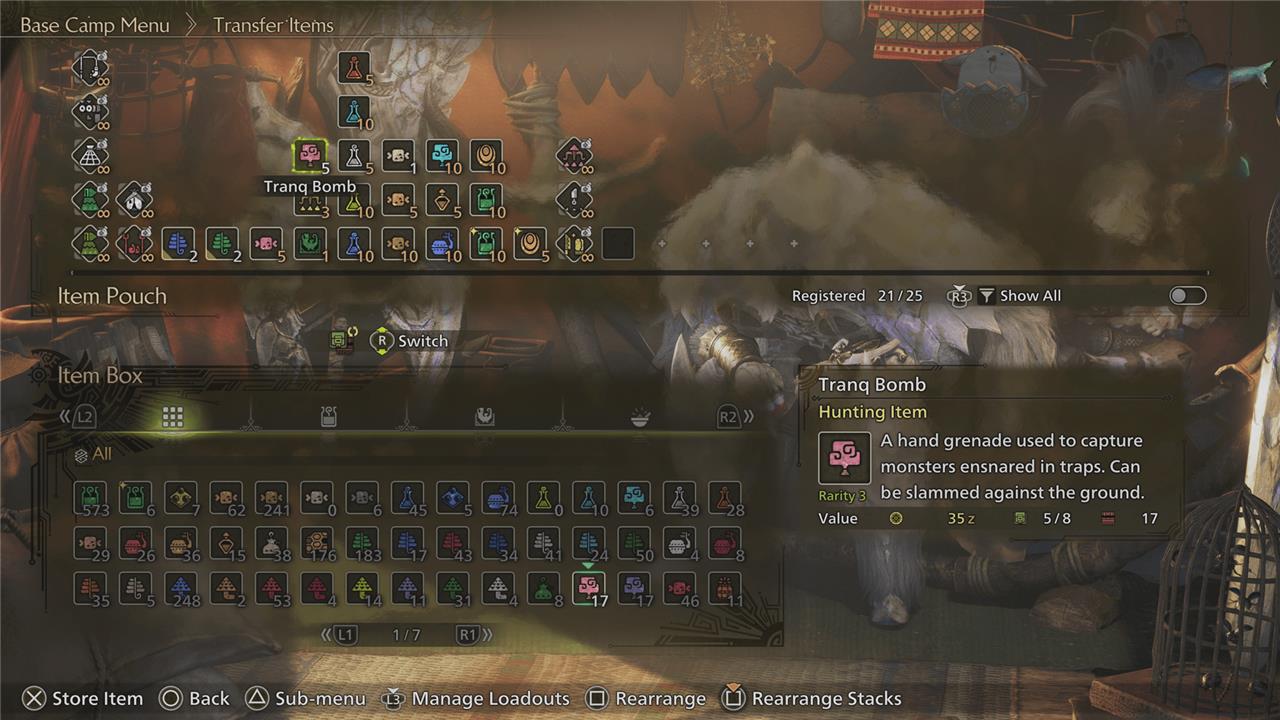
Before you can capture a monster, you’ll need to make sure you have traps – like shock traps or pitfall traps – and tranq bombs in your item pouch. You don’t have to add them to your radial menu(s), but you do have to be able to access them from the item bar.
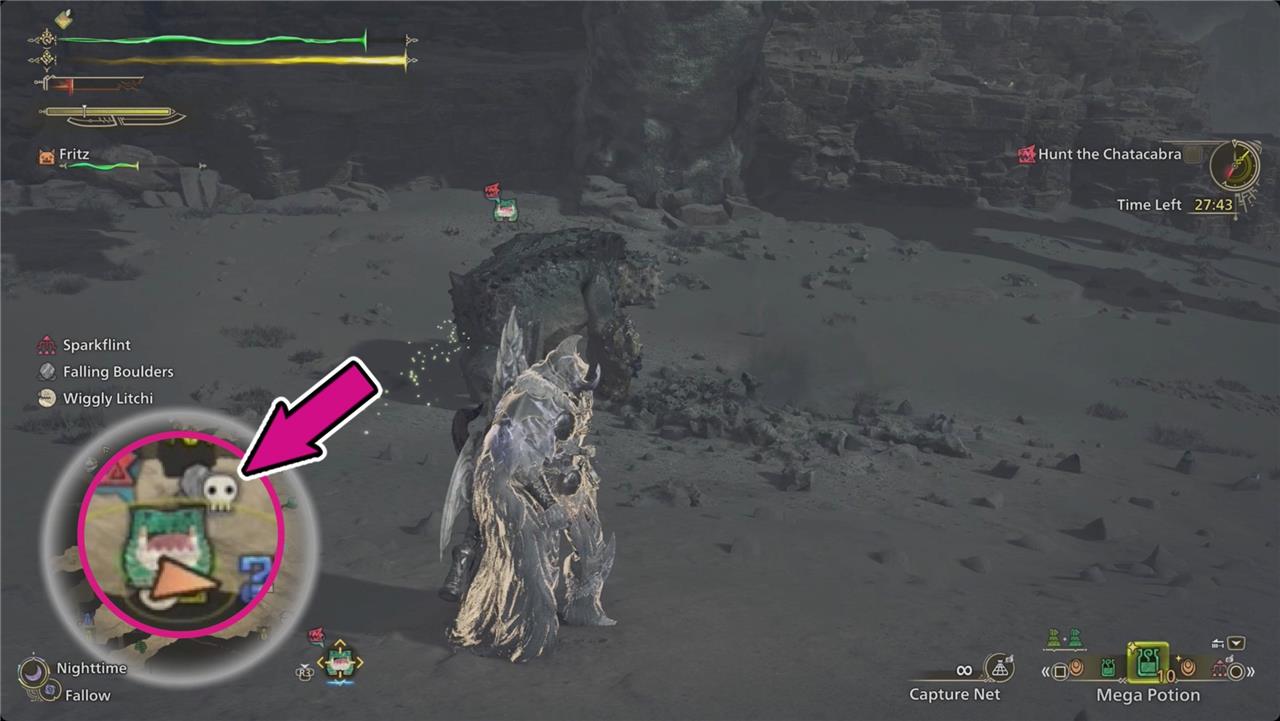
There are two steps to capturing a monster. The first step is to wear a monster down and reduce their health until they’re almost dead. Your palico might say something like, “It’s looking weak! Almost there!” The more reliable clue is when a skull icon appears next to their icon on your minimap.
When the monster is weak, it’s time to trap and capture it. There are a couple more steps now – setting traps and hitting it with tranq bombs. If the monster is weak enough, one or the other might knock it out. If it’s still going strong, you might need to use both.
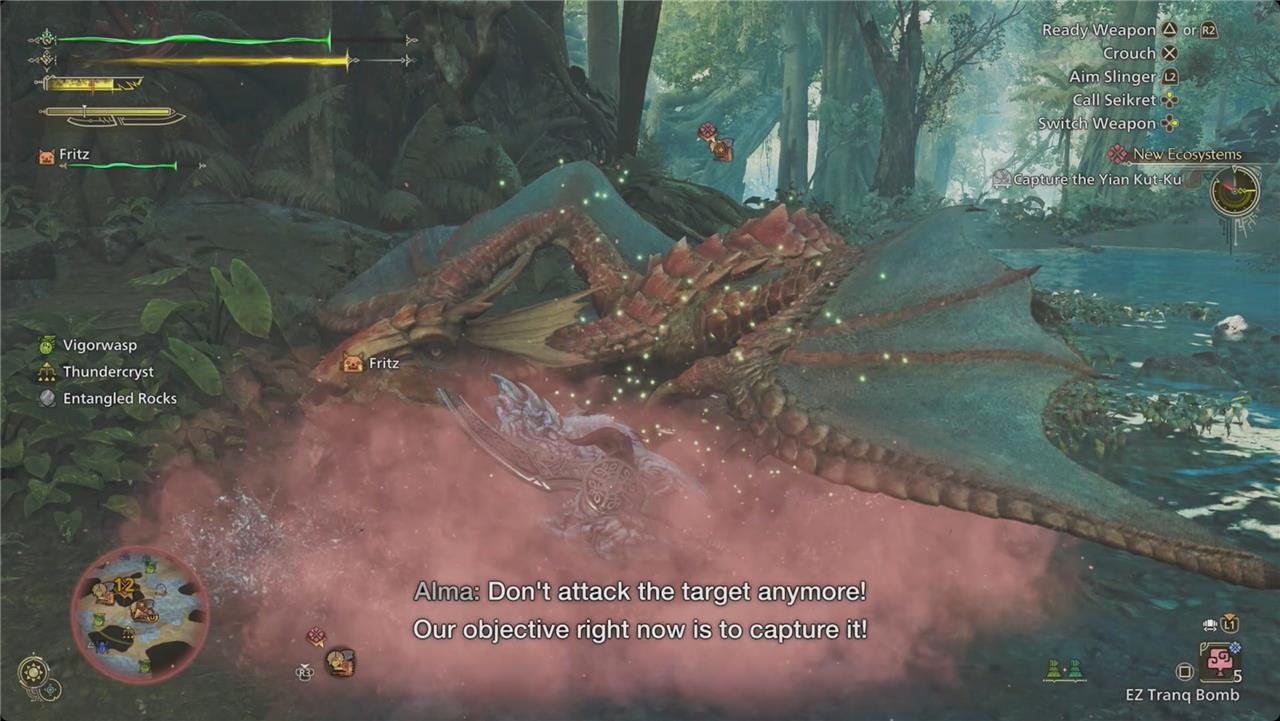
Lay a trap and lead the monster into it. Once it’s ensnared, run up and drop a few tranq bombs on or near it. When the monster passes out, you’ll get several rewards for its capture, just like you would if you carved its corpse.
What monsters cannot be captured, or have trap immunity?
In Monster Hunter Wilds, certain monsters cannot be captured or have trap immunity. Monsters that have quest objectives labeled “Slay” must be killed and cannot be captured, while those with “Hunt” objectives can be either slain or captured. Notably, Jin Dahaad, Guardian Arkveld, and Zig Shia are examples of monsters that cannot be captured, with Jin Dahaad being too large for traps to work effectively. Additionally, some large monsters have immunities to traps, making capturing them impossible or very difficult. For instance, certain story-related guardians and some large monsters are immune to Shock and Pitfall Traps, preventing capture attempts. Thus, understanding the quest objective and monster type is key to knowing if capturing is an option.
A few large monsters have immunities to the traps you’ll be using to capture them.
- Rey Dau, Zoh Shia, and Gypceros cannot be paralyzed by a shock trap
- Jin Dahaadand Zoh Shia can’t be trapped by a pitfall trap
Zoh Shia is the only monster that can’t be captured at all. Anything else will succumb to tranq bombs once you have it trapped.
How to craft traps and tranq bombs
To craft traps and tranq bombs in Monster Hunter Wilds, you first need to gather specific materials and then use the crafting menu at any camp or your tent. For traps, you can craft Shock Traps using 1 Trap Tool and 1 Thunderbug Capacitor, and Pitfall Traps using 1 Trap Tool and 1 Net (the Net is made from 1 Ivy and 1 Spiderweb). Tranq Bombs require 1 Sleep Herb and 1 Parashroom. Access the crafting list under the “Traps/Offense” tab in the item menu to create these items, ensuring you have the necessary ingredients on hand. Trap Tools can be purchased from the Base Camp Provisions Manager, while Thunderbug Capacitors, Sleep Herbs, Parashrooms, Ivy, and Spiderwebs are found throughout the game world, often marked on your map. Carry multiple traps and tranq bombs to increase your chances of successfully capturing monsters, as traps immobilize them and tranq bombs put them to sleep for capture.
Crafting the items you need for capturing a monster will take a bit of work. For traps, you’ll need to buy trap tools from the provisioner in any base camp.
The items you’ll need to craft include:
- Pitfall trap – 1 trap tool and 1 net (made from 1 ivy and 1 spider web). You can find ivy in Windward Plains and Scarlet Forest. For spider webs, you need to look someplace where there are spiders. You can find some in Scarlet Forest, Oilwell Basin, and Iceshard Cliffs.
- Shock trap – 1 trap tool and 1 thunderbug capacitor. You’ll make thunderbug capacitors by collecting thunderbugs. You’ll only find those in Windward Plains.
- Tranq bomb – 1 sleep herb and 1 parashroom. Sleep herbs can be found in Windswept Plains, Scarlet Forest, and Iceshard Cliffs. For parashrooms, all four regions – Windward Plains, Scarlet Forest, Oilwell Basin, and Iceshard Cliffs – have them.
How to capture endemic life in Monster Hunter Wilds
To capture endemic life in Monster Hunter Wilds, equip the Capture Net from your inventory or Slinger and aim at the small creatures like insects or lizards you want to catch. When your reticle changes to a yellow-orange color, it indicates the creature is within range for capture. Use the net carefully by pressing the appropriate button (R2/RT) to catch the creature without startling it. Some endemic life can be elusive, so using stealth tactics such as the Ghillie Mantle or hiding in bushes can help you approach them more easily. Captured endemic life is sent to the Expedition Command tent at the base camp, where you can observe them and earn Guild Points, which are useful for advancing your hunter rank and establishing camps. While capturing endemic life doesn’t provide crafting materials, it offers strategic benefits and contributes to your overall progress in the game.
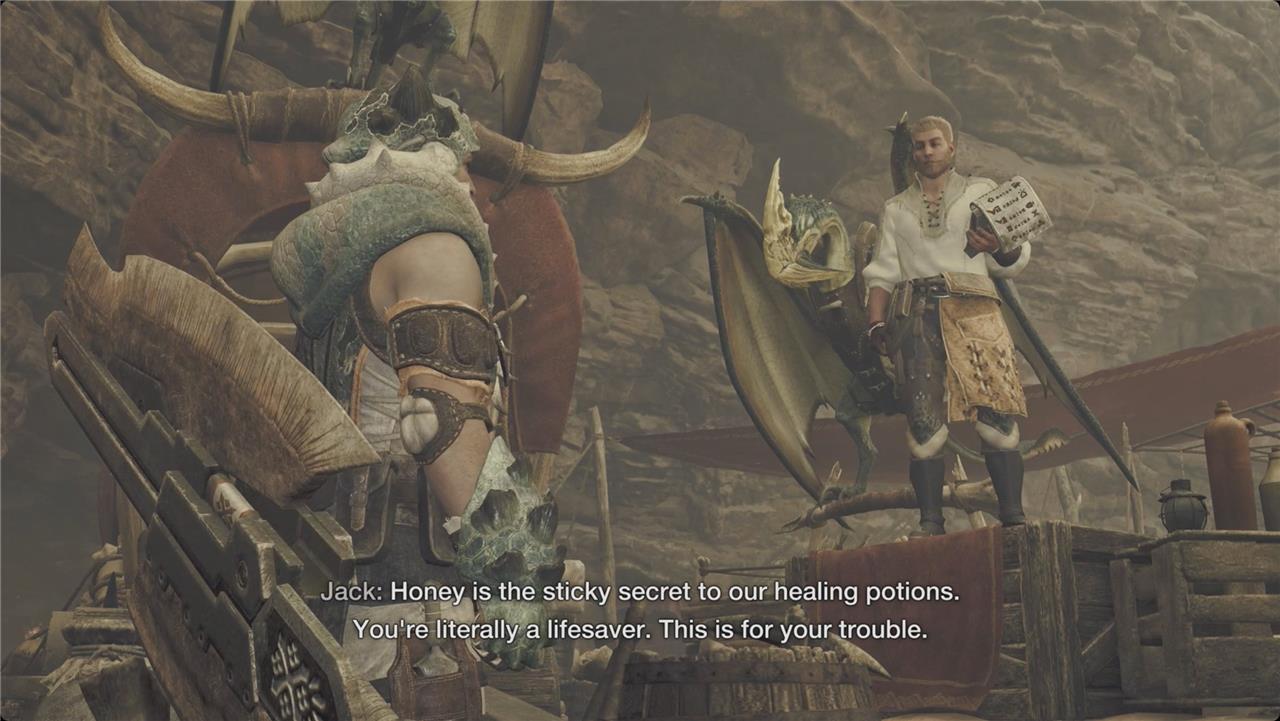
First, know you can’t capture any endemic life in Monster Hunter Wilds until after you attempt to visit Y’sai’s village and get turned away in Chapter 1. On your way back to the base camp in Windward Plains, you’ll meet your first Doshaguma and gather some honey.
When you drop off the honey at the provisions shop, he’ll give you your Essential Items: a portable BBQ grill (for cooking), fishing rod (for fishing), binoculars, capture net, throwing knife, paint pod, and ghillie mantle.
The capture net is what you’re after. To equip it on your bow caster, hold down L1/LB, hit down on the D-pad, and then move the right thumbstick to the upper right to highlight the net in your Essential Items.
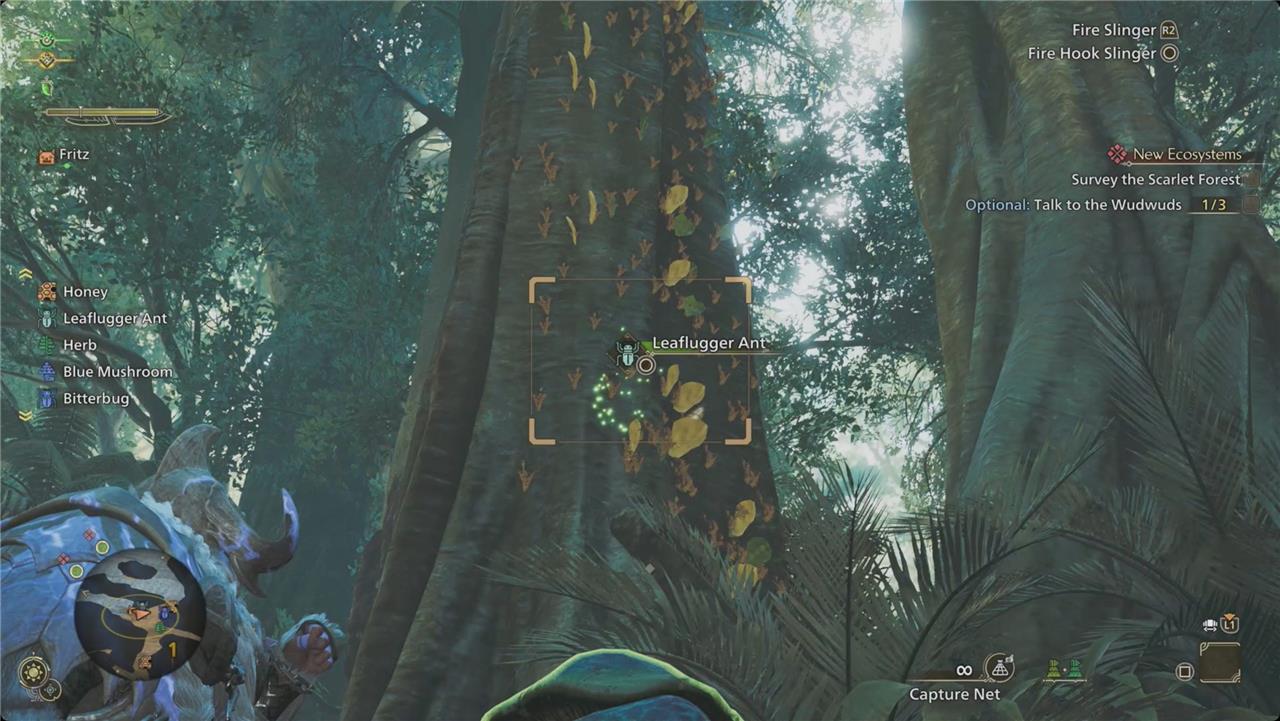
Once you have thecapture net, capturing endemic life is just kind of point and click. When you spot an interesting bug or lizard, you just need to equip your capture net. Aim it at what you want to capture. If it’s something you can nab, the reticle will turn yellow-orange. You’ll fire the capture net with R2/RT.
Just make sure you don’t fire the hook slinger with circle/B instead. That will collect the creature instead of capturing it.
Capturing endemic life this way doesn’t get you any materials, but it does earn you Guild Points that you’ll use for things like building pop-up camps and increasing your hunter rank on your way to High Rank.
What secret tactics can I use to catch elusive endemic life in Wilds
To catch elusive endemic life in Monster Hunter Wilds, use these secret tactics:
-
Always equip your Capture Net via the Hook Slinger and aim carefully to avoid startling the creatures, as many like the Dapperwing or Sandstar flee quickly if approached too fast.
-
Study the habitat, behavior, and specific environmental conditions such as weather (Plenty, Fallow, or Inclemencies) and time of day (morning, night) since many rare endemic creatures only appear under these precise circumstances.
-
Use stealth tools like the Ghillie Mantle to approach without detection and hide in bushes to avoid alarming the creatures.
-
For the most skittish creatures, stun them with Screamer Pods before deploying your Capture Net, ensuring they don’t escape-this is especially effective for rare and fast-moving endemic life like the Sandstar or Prism Hercudrome.
-
Position yourself strategically, such as directly above burrowing creatures, to improve capture chances.
-
Be patient and observe movement patterns to time your capture perfectly, as rushing often causes the creatures to flee.
These tactics will help you successfully capture rare and elusive endemic life, enhancing your collection and unlocking useful gameplay benefits.
How can I identify the best moments to capture elusive endemic life in Wilds
To identify the best moments to capture elusive endemic life in Monster Hunter Wilds, focus on these key factors:
-
Time of Day: Many rare endemic creatures appear only during specific times such as morning, daytime, or nighttime. For example, the Sandstar appears at night in the Windward Plains.
-
Weather Conditions: Certain endemic life emerges only under particular weather states like Plenty, Fallow, or Inclemencies. For instance, the Sandstar and Prism Hercudrome appear during Plenty or Fallow weather, while the Hymstrigian shows up during Inclemencies.
-
Habitat and Location: Study the creature’s preferred environment-some cling to rock walls, others roam sandy plains or ancient ruins. Knowing their exact sectors and terrain helps pinpoint where to look.
-
Behavior Patterns: Observe movement and activity carefully; many creatures flee if startled. Patience and timing your approach to avoid detection are crucial.
-
Use of Tools: Employ Screamer Pods to stun alert creatures like the Sandstar before capturing them with the Capture Net, increasing your success rate.
By combining these observations-optimal time, weather, location, and careful approach-you can maximize your chances of capturing elusive endemic life in the Wilds.
